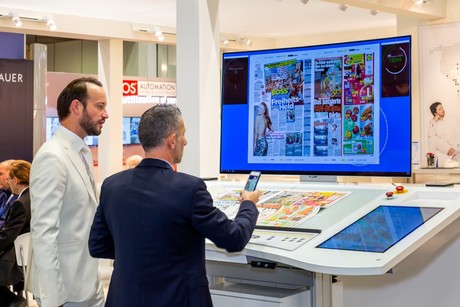For almost 100 years Linotype machines were the ultimate typesetting tools of newspapers. They produced hot-metal “lines of types” that could be arranged to columns and pages. Under the leadership of Kummer Linotype – together with Apple and Adobe – introduced PostScript-based publishing systems to the graphic industry.
Linotype was originally the product name of the machine designed by the German engineer Ottmar Mergenthaler and first introduced in the USA in 1886. At that time there were already web presses available that could produce newspapers in large format relatively quickly. But typesetting was still operated manually and did not come with the required speed of newspaper production.
A group of American newspaper publishers (New York Tribune, Louisville Courier Journal, Chicago News, McNally & Company of Chicago, Washington Post and Chicago Inter-Ocean) financed the development of Mergenthaler’s hot-metal typesetting machine by the National Typographic Company. In 1886 the first machine was presented at the New York Tribune. The publisher is said to have called “A line of types!”. Thus the name for this machine was found: “Linotype”.
The Linotype began its triumph over the world and became the ultimate typesetting tool of newspaper production for decades. It was only in the 1960s that new technologies such as offset printing and photo typesetting questioned the future viability of hot-metal. In 1967, Wolfgang Kummer became Managing Director of Linotype GmbH, and in 1973 he was appointed Chairman of the Management Board. Under his management, the structural change in the graphic industry – from mechanical engineering to electronics, from hot-metal to the photo typesetting – was recognised at an early stage. In 1972 the originally American company Linotype set up a production facility in Eschborn near Frankfurt am Main and moved the company headquarters there in 1974.
 Linotype Operators (Source: pinterest.de)
Linotype Operators (Source: pinterest.de)
The year 1976 marked the end of the old Linotype technology. To the surprise of many experts, Kummer discontinued the construction of hot-metal typesetting machines. By linking the traditional typesetting technology with the computer industry, the Linotype Group began another economic boom. However, the systems of the various manufacturers were still based on proprietary hardware and software. This made it impossible to combine components of one manufacturer with those of others.
That changed only in the middle of the 80s. In 1984 Linotype started to develop laser film-imagesetters that were able to expose not only fonts, but also graphics and images in print-ready resolution of 2,540 dots per inch. At the same time, Apple introduced the then revolutionary WYSIWYG concept (What you see is what you get) with the Macintosh on the market. And with the universal page description language PostScript Adobe provided the technology to connected input and output devices with each other.
 Linotronic 300 and 200 with PostScript RIP, left to right (Source: wirebids.com)
Linotronic 300 and 200 with PostScript RIP, left to right (Source: wirebids.com)
And again, Wolfgang Kummers was the first to recognise the potential of what was then known as desktop publishing (DTP). Linotype developed the first high-resolution raster image processor (RIP) that enabled PostScript-based and professional photo-typesetting using Macintosh PCs. The Linotronic 300 (for commercial typesetting) and Linotronic 500 (for newspaper production) were the first and for a long time the only output systems to be used for desktop publishing.
The company Linotype does not exist any more. After a merger with the scanner manufacturer Dr.-Ing. Rudolf Hell GmbH in 1990, the new company Linotype-Hell AG was also taken over by Heidelberger Druckmaschinen AG in 1996. In 2002, the development of scanners and then film imagesetters came to an end.
The name of Wolfgang Kummers is combined with the successful mastering of a twofold transformation of newspaper prepress and editorial technology and business, which ultimately led to the transition from the printed newspaper to digital publishing.
Congratulations on the ninetieth birthday!





